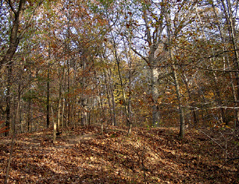#13
Examine the soil here; you'll find it's very sandy. The large
particle size of sand means that rain drains through it quickly,
and therefore this soil is dr y
(xeric) in nature. There is also very little organic material
in this soil, except in the topmost inch or so. These two factors
explain why the most common ground covers are lichens, mosses
and fungi. These simple, non-vascular plants (and related kinds
of organisms) can grow reasonably well in such harsh conditions,
but they are frequently out-competed by grasses and herbs in
richer soils. Sandy soil is not common on most of the UMBC campus
and in Catonsville to the north. However, to the south and east,
sandy soil is much more common. UMBC's CERA is atop the junction
of two of Maryland's physiographic zones, the Piedmont and the
Coastal Plain. Piedmont soils are complex, fairly rich in nutrients,
and feature much clay and many stones. Coastal Plain soils are
much coarser and sandier, descended from alluvial runoff from
the uplands to the west and north.
y
(xeric) in nature. There is also very little organic material
in this soil, except in the topmost inch or so. These two factors
explain why the most common ground covers are lichens, mosses
and fungi. These simple, non-vascular plants (and related kinds
of organisms) can grow reasonably well in such harsh conditions,
but they are frequently out-competed by grasses and herbs in
richer soils. Sandy soil is not common on most of the UMBC campus
and in Catonsville to the north. However, to the south and east,
sandy soil is much more common. UMBC's CERA is atop the junction
of two of Maryland's physiographic zones, the Piedmont and the
Coastal Plain. Piedmont soils are complex, fairly rich in nutrients,
and feature much clay and many stones. Coastal Plain soils are
much coarser and sandier, descended from alluvial runoff from
the uplands to the west and north.





